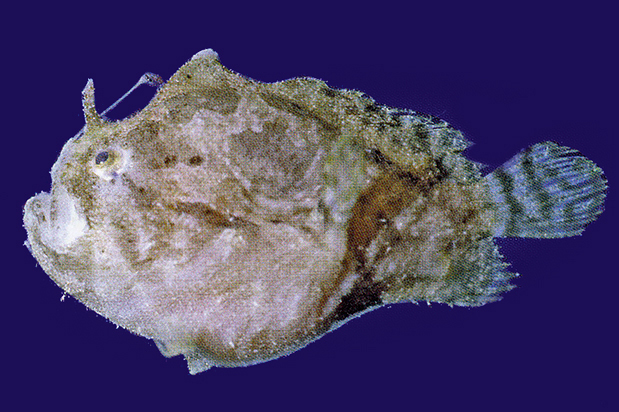Tailjet Anglerfish, Antennarius analis (Schultz 1957)

A Tailjet Anglerfish, Antennatus analis, at Christmas Island, Indian Ocean. Source: Gerald R. Allen / FishBase. License: All rights reserved
Tailjet Anglerfish lack a distinct caudal peduncle, and are unique in having their gill openings far back on the body near the base of the anal-fin, rather than near the pectoral-fin base. The first dorsal spine (illicium) is twice the length of the 2nd dorsal-fin spine and the esca (lure or bait) has several long filaments.
Individuals are camouflaged to match their surroundings, and are often a pale-yellowish grey, with faint mottlings and yellowish fins.
Tailjet Anglerfish, Antennarius analis (Schultz 1957)
More Info
|
Distribution |
Known in Australian waters from Rowley Shoals, Northwest Shelf, to Cartier Island, Western Australia, and also from the Australian territory of Christmas Island. Elsewhere widespread in the tropical East-Indo-West-Central Pacific, from Christmas Island in the eastern Indian Ocean, to the Society Islands, Hawaii and Micronesia, and north to southern Japan. Tailjet Anglerfish hide in crevices and amongst rubble in tide pools and on outer coral reef slopes. |
|
Features |
Meristic features: Dorsal fin III, 12-13 (rarely 13); Anal fin 6-7 (rarely 6); Pectoral fin 9-10 (rarely 9). Gill openings located far back on body at base of anal fin; first dorsal-fin spine (illicium) twice length of 2nd dorsal-fin spine; esca elongate, tapering with several slender filaments and a cluster of darkly pigmented, spherical swellings at base; 2nd dorsal-fin spine more or less straight; gill openings located far back near the anal fin origin. Caudal peduncle absent; membranous posterior-most margin of soft-dorsal and anal fins connected to body at base of outermost rays of caudal fin; prehensile pectoral fins with an ‘elbow-like’ joint; pelvic fins with a short, slender spine and 5 soft rays, last ray of pelvic fin simple. Skin covered with close-set bifurcated spinules. |
|
Size |
To 8.5 cm standard length (SL), 10 cm total length (TL). |
|
Colour |
Body light yellow-grey with faint mottling, fins more yellowish than body. |
|
Feeding |
Anglerfishes are superbly camouflaged ambush predators with highly variable colour patterns to match their surroundings. Tailjet Anglerfish remain very still, only wriggling the lure (esca) in front of their mouth to entice prey to come within striking distance. |
|
Biology |
The sexes are separate and fertilization is external. Females lay thousands of pelagic eggs (to 1 mm) in a large buoyant gelatinous mass or egg raft. the raft remains intact until the pelagic larvae hatch at about 1.6 mm. |
|
Fisheries |
Of no interest to fisheries, and not collected for the aquarium industry. |
|
Conservation |
IUCN Red List: Least Concern EPBC Act: Not listed |
|
Similar Species |
Tailjet Anglerfish are unique in the genus in having the gill openings far back on the body near the origin of the anal fin. Other species have the gill opening near the pectoral-fin base. |
|
Etymology |
Antennarius is from the Latin, antenna, meaning sensory organ, in reference to the modified first dorsal-fin spine. The species is named analis in reference to the position of the gill opening near the anal-fin origin. |
|
Species Citation |
Abantennarius analis Schultz 1957, Proc. U.S. Natl. Mus. 107(3383): 67, fig. 2. Type locality: Oahu, Hawaiian Islands. |
|
Author |
Dianne J. Bray & Vanessa J. Thompson |
Tailjet Anglerfish, Antennarius analis (Schultz 1957)
References
Allen, G.R., N.J. Cross, D.J. Bray & D.F. Hoese. 2006. Family Antennariidae, pp. 637-646. In Beesley PL & Wells A (eds) Zoological catalogue of Australia. Volume 35. ABRS & CSIRO Publishing: Australia Part 1, pp xxiv 1-670.
Allen, G.R. & Erdmann, M.V. 2012. Reef fishes of the East Indies. Perth : Tropical Reef Research 3 vols, 1260 pp.
Allen, G.R., R.C. Steene & M. Orchard. 2007. Fishes of Christmas Island Indian Ocean. 2nd Ed. Christmas Island Natural History Association, Christmas Island, Indian Ocean, Australia. 284 p.
Arnold, R.J. & T.W. Pietsch, 2012. Evolutionary history of frogfishes (Teleostei: Lophiiformes: Antennariidae): a molecular approach. Molecular Phylogenetics and Evolution 62:117-129.
Collette, B., Matsuura, K., Nelson, J., Dooley, J., Fritzsche, R. & Carpenter, K. 2010. Antennarius analis. In: IUCN 2012. IUCN Red List of Threatened Species. Version 2012.1.
Endo, H. & E. Katayama. 2012. A rare frogfish, Antennarius analis (Lophiiformes: Antennariidae), collected from Kakeroma-jima Island, Amami Islands. Nature of Kagoshima 38: 47–50.
Hutchins, J.B. 2001. Checklist of the fishes of Western Australia. Records of the Western Australian Museum Supplement 63: 9-50.
Kon, T. & T. Yoshino. 1999. Record of the frogfish (Lophiformes: Antennariidae), Antennarius analis, from Japan, with comments on its authorship. Japanese Journal of Ichthyology 46(2): 100-103. [In Japanese, English abstract.]
Myers, R.F. 1999. Micronesian reef fishes: a comprehensive guide to the coral reef fishes of Micronesia. 3rd edition. Coral Graphics, Barrigada, Guam. 330 p.
Pietsch T.W. 1984. The Genera of Frogfishes (Family Antennariidae). Copeia 1984(1): 27-44.
Pietsch, T.W. 1999. Antennariidae: Frogfishes (also seamice, anglerfishes), p. 2013-2015, In Carpenter, K.E. & V.H. Niem. Species identification guide for fisheries purposes. The living marine resources of the western central Pacific. Batoid fishes, chimeras and bony fishes. Part 1 (Elopidae to Linophrynidae). FAO, Rome.
Pietsch, T.W. & Grobecker, D.B. 1987. Frogfishes of the World: Systematics, Zoogeography, and Behavioural Ecology. Palo Alto: Stanford University Press, 420 p.
Randall, J.E. 2005. Reef and Shore Fishes of the South Pacific. University of Hawaii Press, Honolulu. 707 p.
Schultz, L.P. 1957. The frogfishes of the family Antennariidae. Proc. U.S. Natl. Mus. 107(3383): 47-105 figs 1-7 pls 1-14



